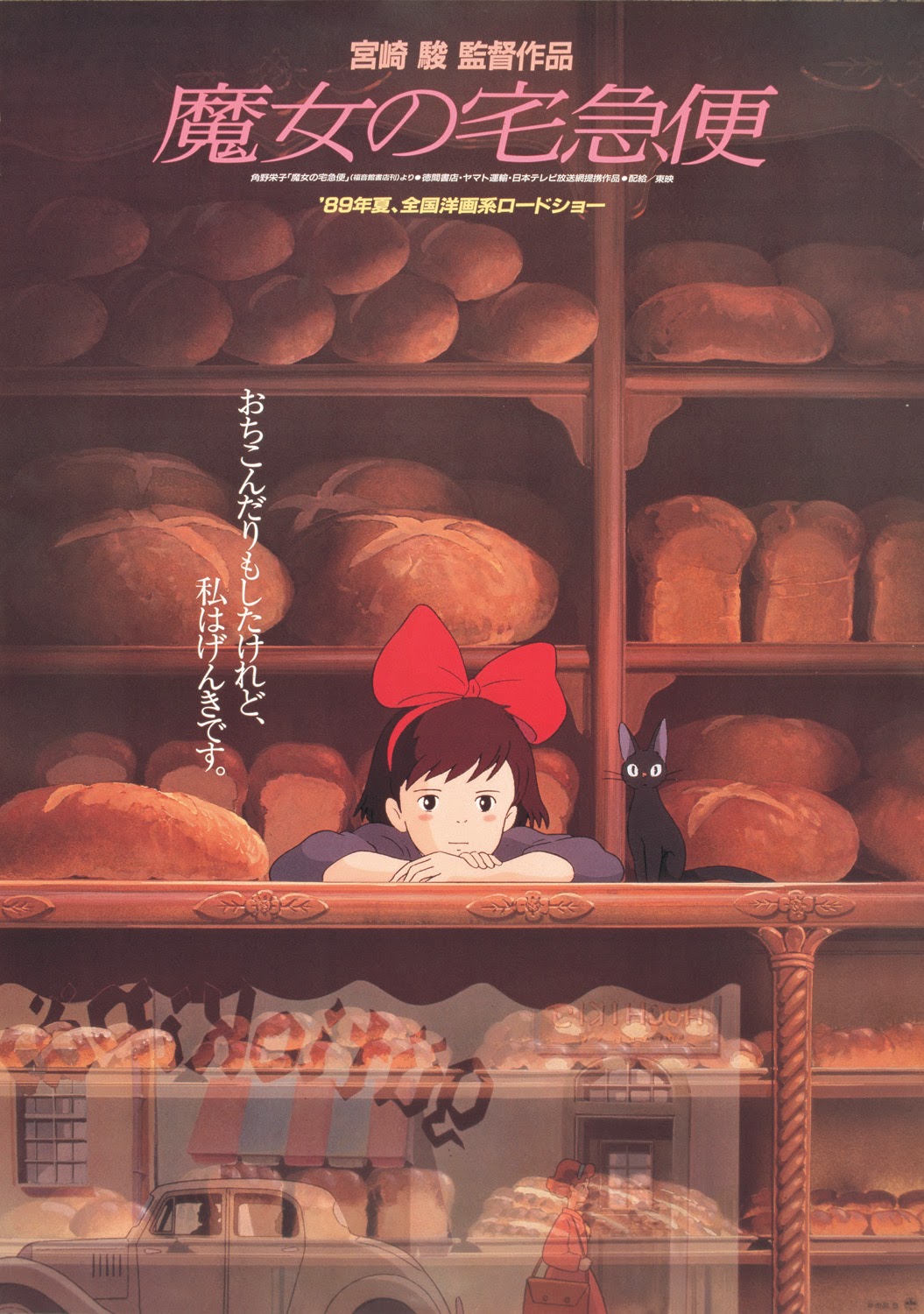A broom, a black
cat and black gown; all that’s missing for Kiki is a pointy hat. Miyazaki’s
fifth film (and third for Studio Ghibli) adapts a novel of the same name by
Eiko Kadono, but still fits neatly into the Ghibli canon. A young-female protagonist,
an anthropomorphic animal and lots of flying means that Kiki’s Delivery Service is Miyazaki in very comfortable territory.
Kiki has made
a decision – today is the day she progresses into witch-hood. An important day
to witch families, Kiki has to leave home and, on board a broom, fly to another
village to start her own, independent life. Settling down in a Paris-sounding
and San-Francisco-looking Japanese, beach-front town, Kiki makes her home. With
the help of pregnant-baker Osono, artist Ursula and Where’s-Wally-lookalike Tombo, Kiki sets up her business despite
the personal challenges she has growing up as a witch. Throughout, Kiki has her
faithful sidekick and droll cat Jiji to keep her company.
Miyazaki’s
pervious film, My Neighbour Totoro,
hints at the idea that children should be shielded from the brutal reality of
adulthood. In contrast, Kiki’s Delivery
Service is about growth, as Kiki becomes self-aware and independent. Kiki is
thirteen and, considering her cat speaks to her, this could’ve become an
episodic narrative, jumping from one story to another. Miyazaki ensures this
doesn’t happen. Despite her delivery service, flying across the town, the amount
of characters is limited, and purposeful. The bakery couple who provide Kiki
with a home; two old ladies that show Kiki the importance of tradition; a
free-spirit who lives in the woods and paints in the style of Chagall; the
small group of teenagers who are nameless but provide a counter-point to Kiki
and Tombo’s honest and respectful attitude. Considering how busy the town is,
this is concise and measured, proving how considered Miyazaki is when adapting
this story.
The artistry,
like all of Miyazaki’s films, is incredibly impressive. As Kiki flies in the
air, her dress billows and her hair flutters through the wind. A sense of speed
and a cool breeze are amplified by the striking colours of the sky and ocean.
In fact, the finale consisting of a dirigible (a large blimp) breaking free
from its constraints and crashing into the clock tower that welcomed Kiki to
the town, is a neat use of the recurring theme of flight.
But, the unforgettable,
stand-out character is the cat, Jiji. He could be considered a mere supporting
role, akin to the type of quirky characters we see too often in Disney films
(Olaf in Frozen, Pascal in Tangled), but he’s so much more. He is
the cynic to Kiki’s innocent optimism. Her relationship to him, and their funny
dialogue, shows a connection to her witchcraft and childhood. When she loses the
power to speak to him, we feel how mighty the loss is. Has she forgotten how to
be childish and playful? Has she forgotten her past? Indeed, Mushu in Mulan or Abu in Aladdin, seem to be exaggerated comedic characters for the sake of holding
the attention of a young child. Jiji has a thematic and integral link, showing
his own growth as he falls for the cat next door. The graceful and smooth
animation of Jiji is what draws you in while snarky remarks are intelligent and
perfectly pitched.
Kiki’s Delivery Service is uniquely Studio Ghibli, and an
important example of animation rooted in a different set of standards. Miyazaki’s
films often pit modern technology against age-old traditions, and in Kiki’s Delivery Service, it is no
different. These grand tales of change are cinematic and challenging for kids,
as much as they are for grown-ups. The western style of entertaining the entire
family often falls into a context everyone can relate to (toys in Toy Story and fairy tales in Shrek) with characters that speak to
all members of the family alike. In 1989, Studio Ghibli already had a cultural
story and characters, like Jiji, to balance what could be considered twee. The higher-quality,
and crucial difference, is how Kiki’s
Delivery Service hints at bolder, bigger statements – something that would
be bolder still in Howl’s Moving Castle and
Spirited Away, only a few years in
the future…
This post was originally written for Flickering Myth on 21st April 2014



Good review. I think this is one of Ghibli's best. I find it really charming :) Like you said, animation is great!
ReplyDelete